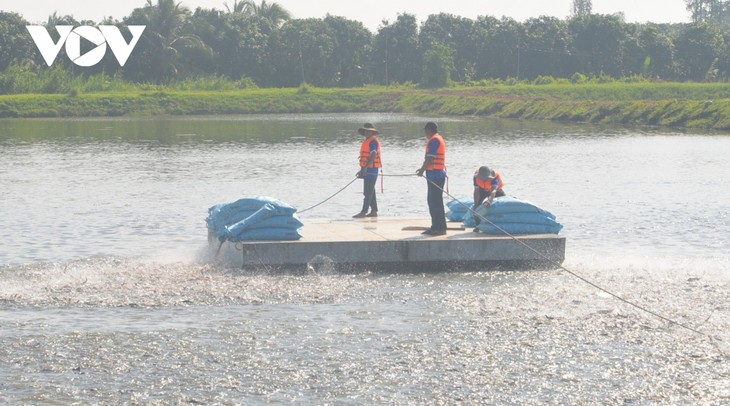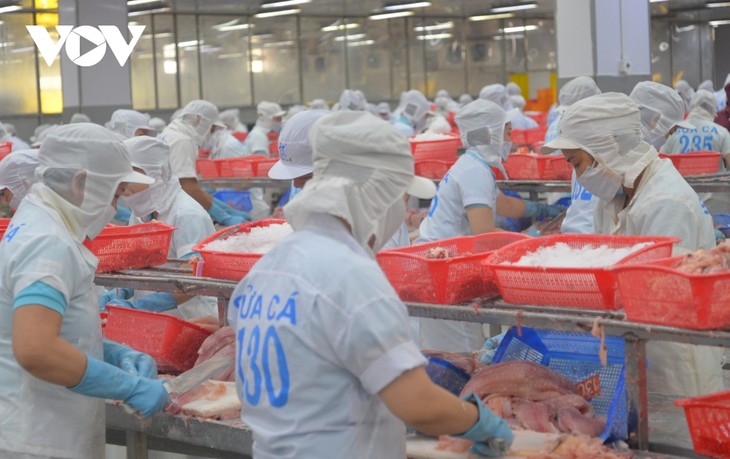(VOVWORLD) - The Mekong Delta region has more than 6,000 hectares of tra fish farming, harvesting an output of 1.5 million tons. Tra fish is one of Vietnam’s key seafood export items. Last year, Vietnam earned 2.4 billion USD from exporting tra fish to 140 markets. To adapt to climate change and reduce emissions in tra fish production, the Mekong Delta is moving toward a circular economy model by applying technical advances in processing, preserving and transportation to improve its sustainable economic value.
 Tra fish is mainly raised in several provinces in the Mekong Delta region. Tra fish is mainly raised in several provinces in the Mekong Delta region. |
Mekong Delta localities including An Giang, Dong Thap, Can Tho, Vinh Long, and Ben Tre provinces are the major tra fish farming areas. They have developed concentrated farming areas and applied farming standards to meet consumer and export needs.
With 700 hectares and an output of 180,000 tons, Can Tho city is applying Global Good Agricultural Practices (GlobalGAP), Aquaculture Stewardship Council (ASC) protocols, Best Management Practices (BMP), and VietGAP standards to provide high quality raw materials for processing exports in order to increase product value.
According to Nguyen Thi Le Hoa, Deputy Director of the Municipal Fisheries Sub-Department, developing a circular economy will increase economic efficiency, product competitiveness and long-term sustainability, address resource scarcity, protect the environment, and respond to climate change.
“Stronger investment in tra fish by‑products processing will be a way to increase the value of tra fish products, helping farmers and processors earn higher income,” Hoa said, adding, “This will also help reduce environmental damage caused by tra fish production. Using fish paste rather than marine fish in tra fish farming will reduce costs for farmers, while enhancing the circular economic model.”
The Vietnamese tra fish is intensively farmed in earthen ponds, using industrial feed, with the farming and management process strictly controlled in accordance with export regulations and standards.
The farming establishments are equipped with modern machinery, equipment and technology to meet the requirements and standards of export markets.
In order to protect the ecological environment while maintaining high economic efficiency, businesses and farming households have treated waste generated from raising tra fish and the processing chain while applying technology to reduce farming costs, decrease emissions into the environment, and increase the overall competitiveness of the industry.
Pham Thi Thu Hong, Deputy Secretary General of the Vietnam Pangasius Association, underscored the need for the tra fish industry to have a sustainable strategy with due attention to environmental protection, especially appropriate and highly practical solutions to waste management and treatment from farming and processing.
“The measures should focus on reducing emissions into the environment as much as possible,” Hong noted.
 The farming establishments are equipped with modern machinery, equipment and technology to meet the requirements and standards of export markets. The farming establishments are equipped with modern machinery, equipment and technology to meet the requirements and standards of export markets. |
Vietnam’s tra fish is exported to 140 countries and territories and is enjoying the advantages brought by new generation free trade agreements to which Vietnam is a signatory.
Dr. Huynh Van Hien of the Fisheries School at Can Tho University underscored the need to focus on fingerling quality, farming, and processing to reduce costs in a circular model and turn out consumer-friendly products because reducing carbon emissions is a major part of the global ambition to fight climate change.
Hien said, “Vietnam has taken interest in responsible production toward a global supply chain. We are building a roadmap to apply the circular economy model and participating in responsible production and emission reduction.”
According to Tran Dinh Luan, Director of the Directorate of Fisheries of the Ministry of Agriculture and Rural Development, public-private partnership is a good approach to sustainably develop the tra fish supply under the circular economy model.
The positive result occurs thanks to connecting the central Government, businesses, scientists, and researchers who are devising ideas for reducing pollution in each link of the tra fish chain.
“Under the PPP (public-private partnership) model, scientific researchers are focusing on technological innovation to increase productivity, efficiency, and reduce damage to the environment,” Luan said, adding, “We’re strengthening studies on by-products to improve in fingerling production, farming, purchasing, and processing. The effective use of by-products by prompt technologies will reduce emissions and make the seafood industry more sustainable.”